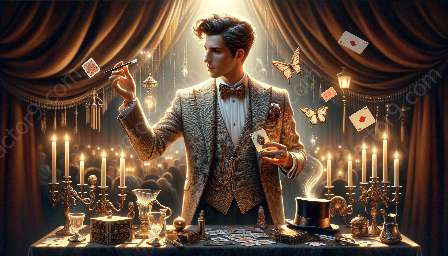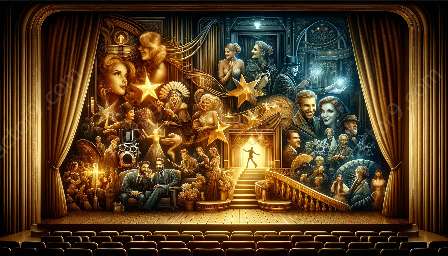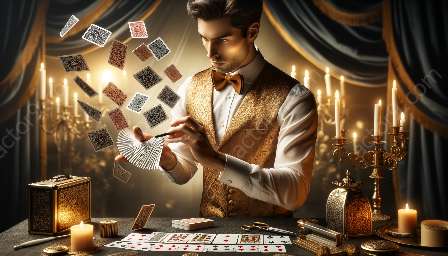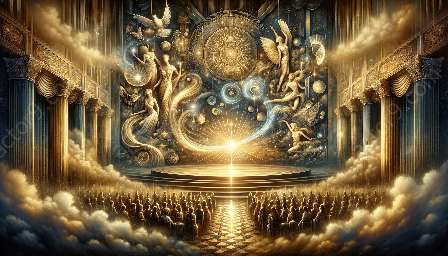Card tricks and manipulations have long been a cornerstone of the world of magic and illusion. However, what truly makes them captivating and intriguing are the psychological and perceptual principles at play. In this topic cluster, we will delve into the intricate connection between psychology, perception, and the art of card manipulations, unravelling the secrets behind these mesmerizing feats of illusion.
The Psychology of Card Manipulations
Understanding the psychology behind card manipulations is crucial to grasping why they captivate audiences. Practitioners of these tricks rely on various psychological concepts to deceive and enthrall their spectators.
Attention and Misdirection
One of the fundamental aspects of psychology in card manipulations is the manipulation of attention and the art of misdirection. Magicians exploit the limited attentional capacities of the human brain, diverting focus away from critical actions or objects. By understanding cognitive limitations and exploiting them, magicians create illusions that astound and baffle even the most attentive observers.
Perceptual Deception
Another fascinating psychological element is the use of perceptual deception. Card manipulations often involve exploiting visual and cognitive illusions to create seemingly impossible effects. Understanding how the human brain perceives and processes visual information is crucial for magicians to effectively distort reality and create awe-inspiring illusions.
The Role of Perception in Card Tricks
Perception plays a pivotal role in the success of card tricks and manipulations. The way individuals perceive and interpret the world around them directly influences the efficacy of these feats of deception. Key aspects of perception in the context of card manipulations include:
- Visual Perception: The manipulation of visual stimuli is central to many card tricks. Magicians exploit the intricate nuances of visual perception to create seamless illusions, taking advantage of how the brain processes and interprets visual information.
- Cognitive Biases: Understanding common cognitive biases allows magicians to exploit these predictable patterns of thinking, leading to successful trickery. Knowledge of cognitive biases empowers magicians to craft tricks that align with the brain's predispositions, enhancing the impact of their performances.
- Reality Distortion: By influencing the perception of reality, magicians can alter the audience's understanding of what is possible, blurring the line between the ordinary and the extraordinary. Perception of reality is a malleable construct that magicians skillfully manipulate to create mind-bending illusions.
The Intricacies of Card Manipulations
Delving deeper into the world of card manipulations unveils the intricate techniques and skills employed to achieve stunning illusions.
Sleight of Hand
Sleight of hand is a cornerstone of card manipulations, requiring precise motor skills and expert timing. Magicians master the art of sleight of hand to seamlessly manipulate cards, creating mesmerizing displays of dexterity and skill.
Psychological Forces
Utilizing psychological forces, magicians guide the choices and decisions of their audience without their conscious awareness. By leveraging psychological principles such as suggestion and influence, magicians manipulate the thoughts and actions of their spectators, enhancing the mystique of their performances.
The Intersection of Psychology, Perception, and Magic
The fusion of psychology, perception, and magic creates a captivating tapestry of intrigue and wonder. As performers harness psychological principles and manipulate perception, they weave a spellbinding narrative that transcends mere trickery, immersing audiences in a world of wonder and enchantment.
Emotional Impact
The synergy of psychology, perception, and magic elicits profound emotional responses from audiences. By understanding the emotive triggers inherent in human psychology, magicians craft performances that evoke awe, disbelief, and joy, forging unforgettable connections with their spectators.
Continual Evolution
Psychology and perception continuously inform the evolution of magic and illusions. As new insights into human cognition and perception emerge, magicians adapt and innovate, pushing the boundaries of what is achievable and reshaping the landscape of magical performances.
As card tricks and manipulations continue to captivate and mystify audiences, the intricate interplay between psychology, perception, and the art of illusion remains an endlessly fascinating realm to explore.


















